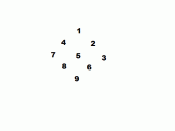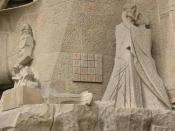Very little is known about the origin of magic squares. Next to nothing is known about the movement of the idea of a magic square before about 1300 AD. Three cultures are known to have created magic squares, the Chinese, the Indian, and the Arabic. In each culture they were viewed as having supernatural properties.
The first magic square in history was created in China by an unknown
mathematician, sometime before the first century AD. "Called the Lo Shu square, it is a magic square of 3 that was said to have appeared on the back of a turtle that came up out of the river. Lo Shu supposedly means "river map," and the story of the appearance of the turtle had to do with a sacrifice to the river god" (http://freespace.virgin.net/mark.farrar1/msqhst01.htm). In 80 AD Ta Tai Li Chi gives the first clear reference to a magic square.
In 570 AD, Shuzun gives an actual description of a magic square of 3. Not until 1275 do we hear of the Chinese making squares of
order larger than 3.
We find the first magic square of 4 in the first century in India by
a mathematician named Nagarajuna. "India is the birthplace of much superior mathematics, and was advanced in many areas of combinatorics at an early date." (http://freespace.virgin.net/mark.farrar1/msqhst01.htm). The next known date in the Indian development is an 11th or 12th century Jaina inscription that includes a magic square of 4. This particular magic square of 4 has unusual properties not found in other magic squares before that time. The whole class of squares having these properties is called "Jaina squares".
"The first magic squares of 5 and 6 appear in an encyclopedia in
Baghdad about 983 AD by Ikhw'n al-Saf' Ras'il, (http://freespace.virgin.net/mark.farrar1/msfmsq01.htm) though several earlier...


